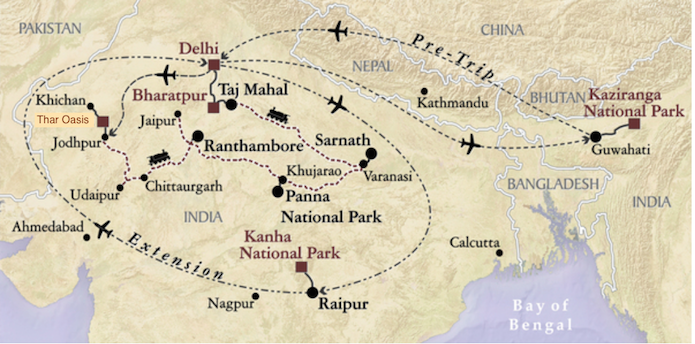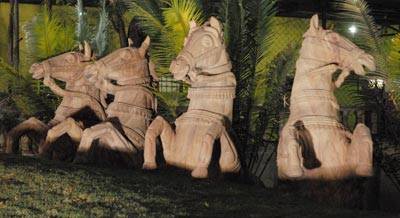
Today we flew south from Delhi to Nagpur and drove to Kanha National Park
(Image courtesy of VENT)
(Click on images to enlarge)

|
We started the day in Delhi in our familiar hotel with the familiar breakfast,
but they had defeated our scheme to lift a couple of granola bars each by not
having put any out. Rats!
We were in the lobby with our suitcases well before the 8am scheduled time and were greeted with one of Gajendra’s nice smiles. Harish was also there, just to help him out. We were soon joined by Kaaren and Stephanie and then on our way to the Delhi airport to fly to Nagpur (west of Raipur on the map above, which is slightly obsolete). The flight involved a bus between the plane and the terminal on both ends, but it was organized ever so much better than at Charles DeGaulle (which Dion described last evening, and we agreed, as “a sort of prison”). In Nagpur we were greeted by signs welcoming us to “the centre of India”. This is a reasonable claim, as Nagpur is the site of the Zero Mile Stone, a monument denoting the geographic center of India. The British used it as a starting point for measuring all distances in India. (We didn’t actually go into Nagpur to see the monument, though.) |
 Zero Mile Stone, Nagpur (Image courtesy of The Times of India) |
|
One very pleasant feature of our road was that now and then it passed through
an avenue of ancient mango trees, obviously past their prime but still a welcome
relief in the dry landscape. Traditionally, good rulers have caused the roads
to be lined with mango trees to provide travelers with shade and, in season,
fruit. Emperor Akbar is said to have planted 100,000 of them. (The mango is
native to India.)
Everywhere we’ve driven in India, we have seen the failure of what must have been a massive project to fill in the gaps in these avenues. We have seen hundreds of sturdy round brick enclosures along the roads that must have been meant to protect newly-planted trees, but, unlike in this photo, every one of them was empty. It seems a great pity.
 Mango tree, a native of India (Image courtesy of Wikimedia Commons) |
 Successful tree protection (Image courtesy of Iain McDonald) |

|
It was well after dark when we arrived at the Baagh Resort and were greeted with glasses of lime juice with salted rims. As soon as we were shown to our room, I set about doing the things that needed doing, such as getting the phone charged so that the alarm will work in the morning (we leave at 5:30) while Lee went off to dinner. I was more than content with a granola bar and the antibiotics graciously bequeathed to me by kind-hearted companions before they flew home (I’ve come down with Lee’s bug, alas). Lee had already figured out that he could use the electric teapot to make us some night-time cough medicine when he got back. He reported that dinner was unusually good. We got to bed as soon as we could. |
| My (not very many) birds for the day: |
| Indian Peafowl | Eastern Cattle Egret | Black-shouldered Kite | Black Kite | Black-winged Stilt |
| Rock Pigeon | Indian Roller | Barn Swallow | Bank Myna |

